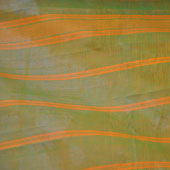Design Resource
Kandangi Saree
The Craft of Chettinadu Saree Making
by
Prof. Bibhudutta Baral, Antony William and Susanth C. S.
The process of weaving starts with making warp and weft. The cotton yarn is bought by the weavers and dyed in desired colors either at home or it is send to dyers operating locally.
Spinning:
Cotton yarns are placed on winding machine for spinning. Sometimes the process is also carried out manually. The yarn is collected on spools.
Warping:
The spools are further taken for making warp on a warping machine. Huge wooden machines are used to make warps.
Winding weft: Weft yarn is wound on a plastic cylinder from the hank. The weft yarn is wound as the weaving progresses. This is done mostly at home by family members who have got time for it.
Piecing:
Piecing is a process where the existing ends on the reed-heald setup is joined with the ends from the new warp but twisting. This pre-weaving process is undertaken by older women in the family.
Weaving:
Finally the loom is loaded with warp and then the weaving starts. While weaving artisans manually mend the broken warp. The woven saree is wrapped on the wooden frame at regular intervals. Artisans pass/ use different colors of contrasting threads while weaving to create designs.
Finishing:
After the saree is made it is taken out from the loom and folded and packed to be sold in market.























